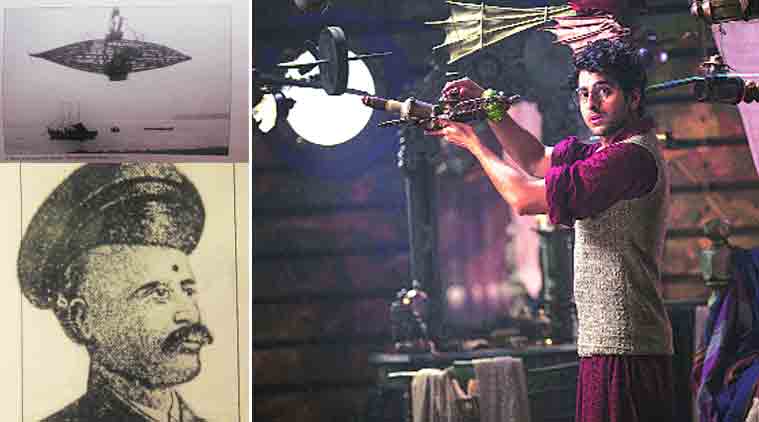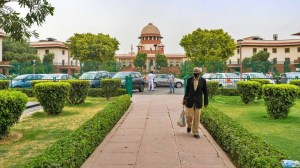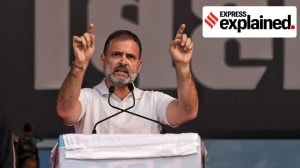- India
- International
Film on ‘Indian who flew first unmanned flight’ topic of discussion at ISC
Paper on ‘Ancient Indian Aviation Technology’ to discuss at length Shivkar Bapuji Talpade’s science behind his experiment.
 Talpade and the sketch of Marutsakha that Pratap Velkar has used in his book Pathare Prabhucha Itihaas; a still from Hawaizaada.
Talpade and the sketch of Marutsakha that Pratap Velkar has used in his book Pathare Prabhucha Itihaas; a still from Hawaizaada.
In a rather ornate-looking laboratory up an attic, a bespectacled Ayushmann Khurrana is busy with his tools. There’s a cylinder, wings and also a set of rotating blades. Using the notes and sketches strewn around, he attempts to piece it all together to build the world’s first flying machine. The scenes are from the theatrical trailer of the film Hawaizaada, where Khurrana essays the role of Shivkar Bapuji Talpade, the man at the centre of discussions at the ongoing Indian Science Congress.
The film, directed by debutant Vibhu Puri, is a “fictional biopic” of Talpade, who some claim constructed and flew the world’s first unmanned flight, based on ancient Indian and Vedic science, in 1895 — “eight years before the Wright brothers did”.
At the ongoing Congress, Captain Anand Bodas, retired principal of a pilot training centre, alongside Ameya Jadhav, lecturer at Mumbai’s Swami Vivekananda International School and Junior College, are set to present a paper on “Ancient Indian Aviation Technology” that will discuss at length Talpade’s science behind his supposed experiment. However, Puri who researched the Mumbai-based scholar, said to have been a professor at the JJ School of Arts, claims information available on Talpade and his craft is contradictory.
“When I approached aviation specialists, engineers and scientists, asking them if Talpade’s craft was indeed the first flying machine, I didn’t get a clear, unanimous response. Some say his craft was conical while others say it resembled a space ship. There is even a claim that he used urine, not mercury as fuel,” said Puri who also spent some time in Pune’s Bhandarkar Institute to go through the “supposedly handwritten notes of Talpade” in order to research for the film.
“I was told that the Vedas describe the fuel as a substance that is neither metal nor a chemical (na dhaatu hai na rasayan). He must have tried a few hundred substances and is likely to have arrived at mercury as the solution,” Puri added.

One of Puri’s research sources is a book, Pathare Prabhucha Itihas (on the Pathare Prabhu community), penned by Mumbai-based architect and historian Pratap Velkar. In his late 70s now, Velkar has dedicated a chapter in his book on Talpade, whom he researched in 1991. He had met Talpade’s niece and also a nephew — neither of them are now alive — apart from D G Bedekar, then an official with the Ministry of Defence who had access to Talpade’s research.
Velkar claims that Talpade’s niece, Roshan Talpade, is said to have seen the skeleton of the “flying machine”. “Talpade had a farmhouse in Madh where she would play on the remains of the flying machine as a child,” he said, adding that Talpade’s machine was more like a “spaceship made of bamboo and cloth, with a cylinder within its hollow”.
However, even Velkar doubts Bodas’s claims that the machine could travel distances. “The experiment, which Talpade called Marutsakha as Bedekar told me, is likely to have failed, after taking flight at Chowpatty for a few yards,” said Velkar, adding that it was important, however, to applaud the efforts made at a time when India was a colony.
Puri, too, said it was in this spirit that the film was made. “It has a lot of fantastical elements, it’s a story of human resilience. I used the information available and constructed the rest of the story around it,” said Puri of Hawaizaada that is produced by Reliance Entertainment and will release on January 30.
dipti.nagpaul@expressindia.com
Apr 25: Latest News
- 01
- 02
- 03
- 04
- 05







































